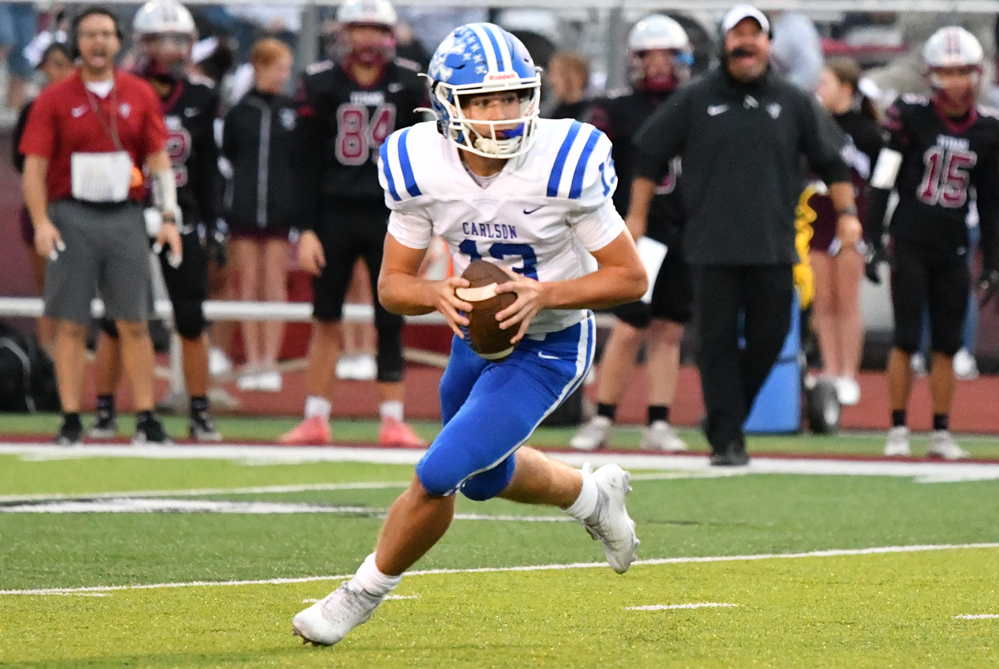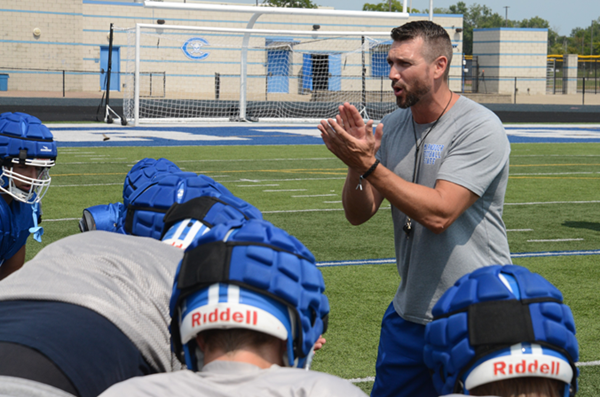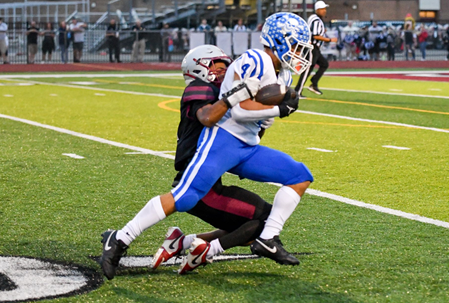
Michigan’s Football Numbers Game – Corrected
September 1, 2017
Today’s blog was written by MHSAA Second Half Editor Geoff Kimmerly
The demise of Michigan high school football has been greatly exaggerated – or, at least, recently misreported by one of the U.S.’s most recognizable newspapers that noted as part of a larger story on football decline that Michigan has seen a “net loss of 57 teams in the past five years.”
It’s easy to understand how this error took place – especially when a reporter is not familiar with the football landscape in our state – but that doesn’t make this statement any less misleading, or harmful considering the story since has been picked up by multiple large news organizations. So let’s quickly clear up the misinterpreted information:
-
The data that led to this error came from an annual participation report released by the National Federation of State High School Associations (NFHS). Every spring, state associations (like the MHSAA) from every state and Washington, D.C., tally up how many of their member schools have a sport and how many athletes play it.
-
For 2016-17, the MHSAA submitted to the NFHS a total of 580 schools with 11-player football – that number actually includes all schools that reported having at least one football player, including primary and secondary schools in co-ops. And yes, that 580 is 57 fewer than the 637 11-player schools the MHSAA submitted for 2012-13.
-
But saying Michigan has lost 57 football programs misses out on something incredibly significant – the MHSAA also submitted 60 schools with 8-player football last year, up from 16 in 2012-13, making that net decrease in football schools over five years 13 – far fewer than 57.
And with a few more brush strokes, the picture of football in our state actually shows a healthy landscape:
-
The 640 schools in Michigan with at least one football player for 2016-17, 11 and 8-player combined, is actually eight more than we reported to the NFHS four years ago and 10 more than three years ago.
-
A better picture of Michigan’s football consistency is shown by how many varsity programs are taking the field. This fall, that number is 616 – 555 11-player varsities and 61 8-player – and we also had 616 for most of the 2016 season, 616 in 2015 and 615 in 2014.
-
We’ve had programs bring back varsity teams this year, and in one case a school has a team on its own for the first time. Benzonia Benzie Central and Suttons Bay were unable to field varsities in 2016, but Benzie Central is back playing 11-player and Suttons Bay is back with an 8-player team. Brimley, an 8-player school going back to 2010, also is fielding a team again after being unable to do so last year. Mount Clemens played only two varsity games in 2016 and forfeited a third, but has seven scheduled for this fall and lost close in its opener last week. And Bear Lake, previously a secondary school in a co-op program, now has a team all its own for the first time and is playing at the 8-player level.
-
Yes, there has been a decrease in Michigan high school football participation when it comes to the number of players – for reasons we discuss frequently, including more extracurricular/entertainment options than ever for students, more who are specializing in other sports and safety fears that often are misplaced. But we’ve also seen a three percent drop in enrollment at MHSAA member schools over the last five years. And despite that trend, Michigan again had the sixth-highest 11-player football participation in the nation in 2016-17 (and seventh-highest in 8-player) while ranking 10th nationally in number of residents of high school age.
-
So yes, while a nine percent drop in the number of football players over the last five years in Michigan clearly is troubling, and something we’re working with the Michigan High School Football Coaches Association to reverse, let’s also put those numbers in perspective. At medium-sized to bigger schools, it could mean a roster of 40 might have only 36 players. A roster of 20 at an 8-player school might go down to 18. Neither would signal the need to eliminate a football program.
-
And that move by so many schools to 8-player? It definitely started as a way for low-participation programs to keep football (and has worked for most of them). While that still may be the driving force as schools move from 11 to 8, others have made the switch because most of their former opponents did and joining them makes scheduling easier and travel shorter. Michigan has a multitude of small towns, and you’ll find most of these 8-player programs in pockets in the thumb, southwest or northern Lower Peninsula, or Upper Peninsula. And keep in mind, only Class D teams remain eligible for the 8-player playoffs – and only two of 61 teams playing 8-player this fall are larger than Class D and its enrollment limit of 203 students for 2017-18.
The story behind “a decrease of 57 schools” clearly is a little complex to explain and explain away, but it’s necessary to do so.
Yes, Michigan’s total number of football players is down a few percent. But the sport’s prominence and importance in our schools and communities remains high.

Carlson's 'Power-Spread' Piling Up Points Despite Missing Leading Rusher
By
Doug Donnelly
Special for MHSAA.com
October 2, 2024
In Johnny Cash’s song “One Piece at a Time,” the main character collects car parts over the years to build a one-of-a-kind automobile.
 At the end of the song, he’s asked what model it is. That’s where he runs into trouble.
At the end of the song, he’s asked what model it is. That’s where he runs into trouble.
“Well, it’s a ’49, ’50, ’51, ’52 …” Cash sings.
That automobile is a lot like the offense that has Gibraltar Carlson’s football team off to a 5-0 start.
“We pride ourselves in running the football here,” third-year head coach Jason Gendron said. “That is our identity. We play power football.”
That’s not the full story, however.
“We are multi-set, really,” Gendron said. “We have Wing-T principles, but we are a spread, Wing-T team that can go tight formations with two tight ends and three running backs. We also can go spread and run some run-pass option things. We also like to run counter off that.
“At the end of the day, power football is where we like to be. We can run that out of multiple sets. Everything we do is based off power.”
Marauders quarterback Joe Krolak agrees. Sort of.
“It’s power-spread,” Krolak said. “It’s hard to describe. We can go under center, or we can go spread.”
No matter what you call it, the Marauders’ offense is clicking in all gears. Carlson is averaging a two-point conversion shy of 50 points a game in their 5-0 start.
That Carlson is having success is not surprising or anything new. The Marauders have won four straight Downriver League championships and have made the playoffs seven years running. The surprising piece this season is they have done it without Division I college recruit Izaiah Wright, the junior running back who rushed for 1,965 yards and 31 touchdowns as a sophomore in leading Carlson to a 10-2 record.
Wright played in Week 1. But on the first offensive series of the game in Week 2, he went down with an ankle injury and hasn’t played since.
 “It’s been a slow recovery,” Gendron said. “He’s been week-to-week. He’s getting closer. I do think he’ll play again this year, but I don’t know if he will be 100 percent this year.”
“It’s been a slow recovery,” Gendron said. “He’s been week-to-week. He’s getting closer. I do think he’ll play again this year, but I don’t know if he will be 100 percent this year.”
In his place, the Marauders were sharing carries among multiple backs until last week when junior Avery Ortiz got the full workload. He responded with 200 yards rushing and multiple touchdowns.
Gendron said he and the Carlson coaches saw the potential in Ortiz.
“Avery has been the running back who has emerged,” Gendron said. “We feel Avery is one of the best backs in our conference and southeast Michigan.”
Ortiz has been Wright’s backup for a couple of seasons. Last year Gendron asked Ortiz about changing positions to get him on the field, and he started playing safety. This season, with Wright out, Ortiz found himself on the offensive side of the ball again.
“He has great vision and is really good on his cuts,” Gendron said. “Avery is a running back at heart. He’s always wanted to be the running back here, but you have a kid in front of him who is a Division I player who beat him out. That’s just the way it goes. At least he was humble enough to accept that and find another place to play. For him to get that back, seize the moment and run with it, is the credit to the type of kid he is.”
Krolak said the offense hasn’t skipped a beat with Ortiz as the featured back.
“Everybody knows in this program it’s next man up,” Krolak said. “We have a lot of athletes in this program who can do the same things he can do. Avery has really stepped up big. He’s looking phenomenal. He’s a great running back and has carried us through this.”
Gendron called Krolak the team’s first-half MVP. Krolak has completed 44 of 62 passes for 669 yards and six touchdowns and rushed for another 406 yards and nine touchdowns.
“Joe is a very dangerous runner and has gotten better at throwing,” Gendron said. “He’s a dual-threat quarterback. You can’t just key on Izaiah or Avery. You have to have eyes on Joe. He’s been the player of the year for us without question. He’s leading us and doing everything I’ve asked him to do at the position. He’s having a great year.”
Krolak, a senior, said he was ready for his number to be called more with Wright out.
“I knew I would get the ball more,” Krolak said. “Coach told me I was going to run the ball more and throw it around, and I was completely ready for it.”
 Carlson has several more weapons, including tight end Drew Sikora and receivers Brendan Stanley and Landon Vida. Everything starts up front, however.
Carlson has several more weapons, including tight end Drew Sikora and receivers Brendan Stanley and Landon Vida. Everything starts up front, however.
“I tell our offensive line that they are the most important position group on the field, both our offensive and defensive lines,” Gendron said. “They have bought in and embraced that and the fact that we want to be a power, smash-mouth football team.”
Carlson’s been pretty good on defense, too, giving up just six touchdowns all season.
Gendron is a Monroe Jefferson graduate who played for Marc Cisco, who retired after 47 years coaching the Bears. That’s where Gendron learned the fundamentals of the game and about power football.
“It works,” Gendron said. “It worked back then for Marc, and it works for us. It’s good football. I believe in it. The kids buy into it. There’s nothing better from an offensive standpoint when you can get three yards at will and you can call the play again and it works.”
The current offense is a mix of Gendron’s years playing at Jefferson and schematic strategies incorporated by Dan Kalbfleisch, the Carlson athletic director and assistant football coach.
“We’ve blended Dan’s experience with his spread concepts and the things I value about offensive football – the ground and pound, power football concepts – into one offense. Dan brings the pre-snap, tempo, no-huddle offense with motion and getting guys into space. That’s what you see. We both believe in running the football.”
Carlson has some tough games ahead, but Gendron is pleased with how the season is shaping up. With a little luck, they might get Wright back in time for a playoff run.
“We are on schedule right now,” he said. “Our guys have done what they need to do at this point. We take things one week at a time. Trenton is on the clock right now.”
 Doug Donnelly has served as a sports and news reporter and city editor over 25 years, writing for the Daily Chief-Union in Upper Sandusky, Ohio from 1992-1995, the Monroe Evening News from 1995-2012 and the Adrian Daily Telegram since 2013. He's also written a book on high school basketball in Monroe County and compiles record books for various schools in southeast Michigan. E-mail him at [email protected] with story ideas for Jackson, Washtenaw, Hillsdale, Lenawee and Monroe counties.
Doug Donnelly has served as a sports and news reporter and city editor over 25 years, writing for the Daily Chief-Union in Upper Sandusky, Ohio from 1992-1995, the Monroe Evening News from 1995-2012 and the Adrian Daily Telegram since 2013. He's also written a book on high school basketball in Monroe County and compiles record books for various schools in southeast Michigan. E-mail him at [email protected] with story ideas for Jackson, Washtenaw, Hillsdale, Lenawee and Monroe counties.
PHOTOS (Top) Gibraltar Carlson quarterback Joe Krolak considers his best option during last week’s win over Southgate Anderson. (Middle) Carlson coach Jason Gendron pumps up his team during a practice. (Below) The Marauders’ Avery Ortiz drags a defender downfield. (Game photos by Kim Britt; practice photo by Niles Kruger/Monroe News.)

